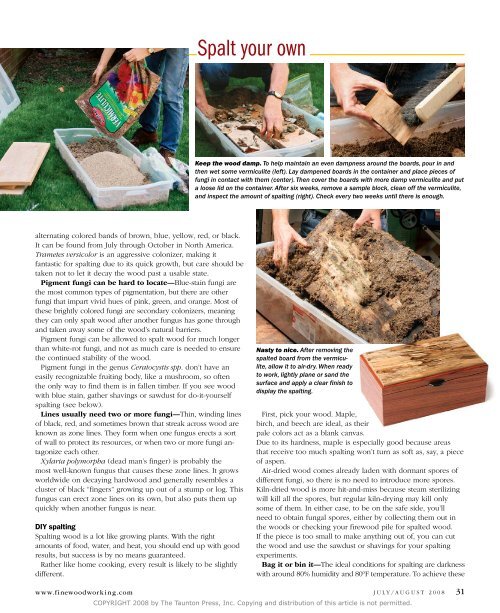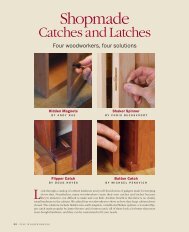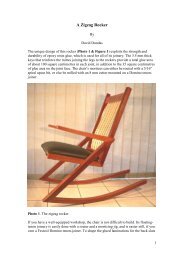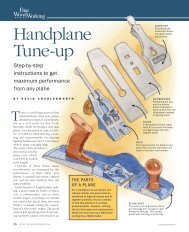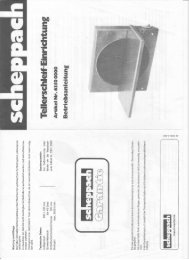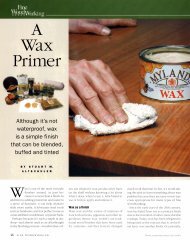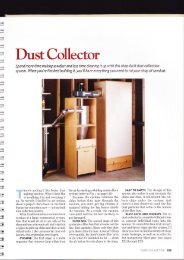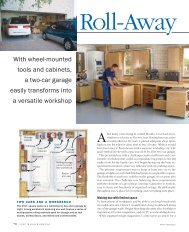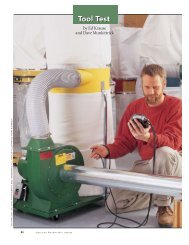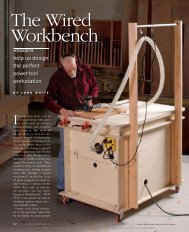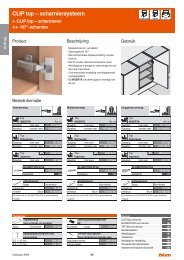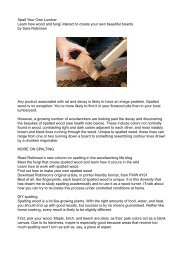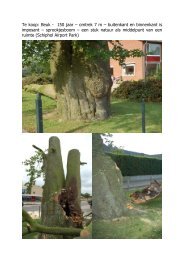Spalted Wood
Spalted Wood
Spalted Wood
Create successful ePaper yourself
Turn your PDF publications into a flip-book with our unique Google optimized e-Paper software.
Spalt your own<br />
Keep the wood damp. To help maintain an even dampness around the boards, pour in and<br />
then wet some vermiculite (left). Lay dampened boards in the container and place pieces of<br />
fungi in contact with them (center). Then cover the boards with more damp vermiculite and put<br />
a loose lid on the container. After six weeks, remove a sample block, clean off the vermiculite,<br />
and inspect the amount of spalting (right). Check every two weeks until there is enough.<br />
alternating colored bands of brown, blue, yellow, red, or black.<br />
It can be found from July through October in North America.<br />
Trametes versicolor is an aggressive colonizer, making it<br />
fantastic for spalting due to its quick growth, but care should be<br />
taken not to let it decay the wood past a usable state.<br />
Pigment fungi can be hard to locate—Blue-stain fungi are<br />
the most common types of pigmentation, but there are other<br />
fungi that impart vivid hues of pink, green, and orange. Most of<br />
these brightly colored fungi are secondary colonizers, meaning<br />
they can only spalt wood after another fungus has gone through<br />
and taken away some of the wood’s natural barriers.<br />
Pigment fungi can be allowed to spalt wood for much longer<br />
than white-rot fungi, and not as much care is needed to ensure<br />
the continued stability of the wood.<br />
Pigment fungi in the genus Ceratocystis spp. don’t have an<br />
easily recognizable fruiting body, like a mushroom, so often<br />
the only way to find them is in fallen timber. If you see wood<br />
with blue stain, gather shavings or sawdust for do-it-yourself<br />
spalting (see below).<br />
Lines usually need two or more fungi—Thin, winding lines<br />
of black, red, and sometimes brown that streak across wood are<br />
known as zone lines. They form when one fungus erects a sort<br />
of wall to protect its resources, or when two or more fungi antagonize<br />
each other.<br />
Xylaria polymorpha (dead man’s finger) is probably the<br />
most well-known fungus that causes these zone lines. It grows<br />
worldwide on decaying hardwood and generally resembles a<br />
cluster of black “fingers” growing up out of a stump or log. This<br />
fungus can erect zone lines on its own, but also puts them up<br />
quickly when another fungus is near.<br />
DIY spalting<br />
Spalting wood is a lot like growing plants. With the right<br />
amounts of food, water, and heat, you should end up with good<br />
results, but success is by no means guaranteed.<br />
rather like home cooking, every result is likely to be slightly<br />
different.<br />
Nasty to nice. After removing the<br />
spalted board from the vermiculite,<br />
allow it to air-dry. When ready<br />
to work, lightly plane or sand the<br />
surface and apply a clear finish to<br />
display the spalting.<br />
First, pick your wood. Maple,<br />
birch, and beech are ideal, as their<br />
pale colors act as a blank canvas.<br />
due to its hardness, maple is especially good because areas<br />
that receive too much spalting won’t turn as soft as, say, a piece<br />
of aspen.<br />
Air-dried wood comes already laden with dormant spores of<br />
different fungi, so there is no need to introduce more spores.<br />
kiln-dried wood is more hit-and-miss because steam sterilizing<br />
will kill all the spores, but regular kiln-drying may kill only<br />
some of them. In either case, to be on the safe side, you’ll<br />
need to obtain fungal spores, either by collecting them out in<br />
the woods or checking your firewood pile for spalted wood.<br />
If the piece is too small to make anything out of, you can cut<br />
the wood and use the sawdust or shavings for your spalting<br />
experiments.<br />
Bag it or bin it—The ideal conditions for spalting are darkness<br />
with around 80% humidity and 80ºF temperature. To achieve these<br />
www.finewoodworking.com July/AuguST 2008 31<br />
COPYRIGHT 2008 by The Taunton Press, Inc. Copying and distribution of this article is not permitted.


